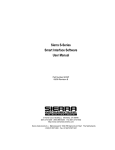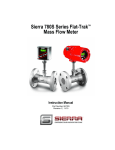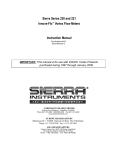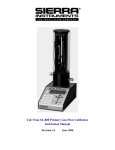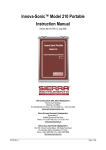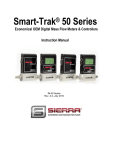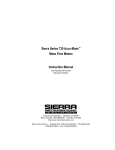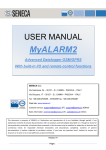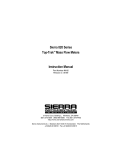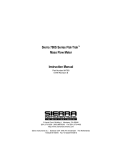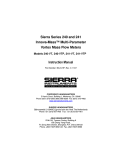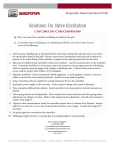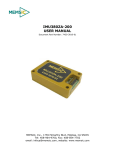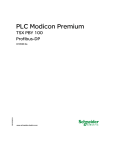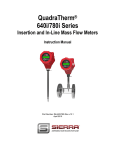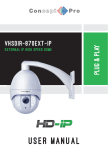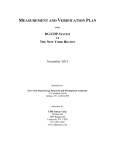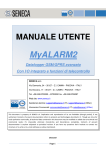Download Compod Control Module Instruction Manual
Transcript
Compod™ Programmable Control Module For 100 Series Digital Mass Flow Meters & Controllers Instruction Manual IM-COMPOD Revision: F, December 2015 CORPORATE HEADQUARTERS 5 Harris Court, Building L, Monterey, CA 93940 USA Phone (831) 373-0200 (800)-866-0200 Fax (831) 373-4402 www.sierrainstruments.com EUROPEAN HEADQUARTERS Bijlmansweid 2 1934RE Egmond aan den Hoef The Netherlands Phone +31 72 507 1400 Fax +31 72 507 1401 ASIA HEADQUARTERS Rm. 618, Tomson Centre, Building A, 188 Zhang Yang Road Pu Dong New District, Shanghai, P. R. China Phone: +86 21 5879 8521 Fax +8621 5879 8586 Compod™ Instruction Manual IM-COMPOD Rev. E 1 IMPORTANT CUSTOMER NOTICE Sierra Instruments, Inc. is not liable for any damage or personal injury, whatsoever, resulting from the use of Sierra Instruments standard mass flow meters or controllers for oxygen gas. You are responsible for determining if this mass flow meter or controller is appropriate for your oxygen application. You are responsible for cleaning the mass flow meter or controller to the degree required for your oxygen flow application. © COPYRIGHT SIERRA INSTRUMENTS 2015 No part of this publication may be copied or distributed, transmitted, transcribed, stored in a retrieval system, or translated into any human or computer language, in any form or by any means, electronic, mechanical, manual, or otherwise, or disclosed to third parties without the express written permission of Sierra Instruments. The information contained in this manual is subject to change without notice. TRADEMARKS Compod™, Smart-Trak®, and Dial-A-Gas™ are trademarks of Sierra Instruments, Inc. Other product and company names listed in this manual are trademarks or trade names of their respective manufacturers. Compod™ Instruction Manual IM-COMPOD Rev. E 2 TABLE OF CONTENTS IMPORTANT CUSTOMER NOTICE ...................................................................................... 2 CHAPTER 1: INTRODUCTION............................................................................................. 7 Safety information ............................................................................................................ 7 CHAPTER 2: INSTALLATION .............................................................................................. 9 CHAPTER 3: ELECTRICAL CONNECTIONS ............................................................................ 9 Pin configuration ............................................................................................................. 10 Instrument and Compod™ power .................................................................................. 11 RS485 connection ............................................................................................................ 11 General 2-wire topology RS485 network ................................................................... 12 Daisy chain units ......................................................................................................... 12 Analog inputs .................................................................................................................. 13 Pulse output .................................................................................................................... 13 Digital outputs................................................................................................................. 13 Relay outputs .............................................................................................................. 13 CHAPTER 4: COMMUNICATING ...................................................................................... 14 Power up ......................................................................................................................... 14 Data format various registers ......................................................................................... 14 Modbus registers overview ............................................................................................ 15 Special – Modbus set up ................................................................................................. 17 Registers explained ......................................................................................................... 17 40001: Actual flow ...................................................................................................... 17 40003: Set point .......................................................................................................... 17 40005 – 40008: Totalizer ............................................................................................. 18 40009: Valve power .................................................................................................... 18 40010 - 40011: Analog inputs 1 & 2 ........................................................................... 18 40012: Digital inputs ................................................................................................... 18 Compod™ Instruction Manual IM-COMPOD Rev. E 3 40013: Digital outputs ................................................................................................. 18 40014: Alarm status .................................................................................................... 18 40015: Factory full scale ............................................................................................. 18 40017: User full scale .................................................................................................. 18 40019: Gas span .......................................................................................................... 19 40021: Trigger point low alarm 1 ............................................................................... 19 40023: Trigger point high alarm 1 .............................................................................. 19 40025: Trigger point low alarm 2 ............................................................................... 19 40027: Trigger point high alarm 2 .............................................................................. 19 40029: Alarm control register ..................................................................................... 19 40030: Trigger source alarm 1 .................................................................................... 19 40031: Trigger source alarm 2 .................................................................................... 19 40032: Analog input settings ...................................................................................... 19 40033: Pulse output control ........................................................................................ 20 40034: Gas index ......................................................................................................... 20 40035: Valve position index ........................................................................................ 21 40036: Flow unit index ................................................................................................ 21 40037: Password ......................................................................................................... 22 40038: Input set point index ....................................................................................... 22 40039: Analog output index ....................................................................................... 22 40040: Firmware revision ........................................................................................... 22 40042: Device type ...................................................................................................... 22 40043 - 40046: Serial number ..................................................................................... 23 40047 - 40051: Tag ...................................................................................................... 23 40052 – 40059: Gas name 1 ........................................................................................ 23 40060 – 40067: Gas name 2 ........................................................................................ 23 Compod™ Instruction Manual IM-COMPOD Rev. E 4 40068 – 40075: Gas name 3 ........................................................................................ 23 40076 – 40083: Gas name 4 ........................................................................................ 23 40084 – 40091: Gas name 5 ........................................................................................ 23 40092 – 40099: Gas name 6 ........................................................................................ 23 40100 – 40107: Gas name 7 ........................................................................................ 23 40108 – 40115: Gas name 8 ........................................................................................ 23 40116 – 40123: Gas name 9 ........................................................................................ 23 40124 – 40131: Gas name 10 ...................................................................................... 23 40132: Sensor data...................................................................................................... 23 40133: Set unit to zero ................................................................................................ 23 40134: Reset unit to factory default ........................................................................... 23 Special Modbus set up registers ..................................................................................... 24 44100: ID...................................................................................................................... 24 44101: Baud rate ......................................................................................................... 24 44102: Parity ............................................................................................................... 24 44103: TX delay ........................................................................................................... 24 44104: Reset unit......................................................................................................... 24 Chapter 5: Alarm system ................................................................................................ 25 Alarm principle ................................................................................................................ 25 Alarm control .................................................................................................................. 25 Alarm control register ................................................................................................. 25 Trigger source .............................................................................................................. 27 Trigger point (level) ..................................................................................................... 27 Alarm status register ................................................................................................... 27 Examples .......................................................................................................................... 28 Flow high and low alarm............................................................................................. 28 Compod™ Instruction Manual IM-COMPOD Rev. E 5 Shut down flow through external push button ......................................................... 29 Fill tank with gas to maintain pressure level ............................................................. 29 Chapter 6: Display module ............................................................................................. 31 Screen modes: ................................................................................................................. 32 Chapter 7: Bootloader.................................................................................................... 33 Introduction .................................................................................................................... 33 Getting started ................................................................................................................ 33 Load Firmware (not typically required)...................................................................... 34 Setup Firmware ........................................................................................................... 36 Quit .............................................................................................................................. 37 Trouble shooting ............................................................................................................. 37 Appendix A: Compod Application Menu…………………………………………………………………………..37 Appendix B: Bootloader ................................................................................................. 45 Introduction ..................................................................................................................... 45 Getting started................................................................................................................. 45 Load Firmware............................................................................................................. 46 Setup Firmware ........................................................................................................... 48 Quit .............................................................................................................................. 49 Trouble shooting.............................................................................................................. 49 Appendix C: Warranty Policy………………………………………………………………………..…………………49 Compod™ Instruction Manual IM-COMPOD Rev. E 6 CHAPTER 1: INTRODUCTION The Compod™ is a Modbus add-on module for Sierra Instruments’ Smart-Trak® Series 100 gas flow measurement and control instruments. A variety of features enable the integration of the Smart-Trak® into a Modbus network environment. Among these features: Access to all vital data Sophisticated alarm system Totalizer Pulse output Analog inputs Smart-Trak® functionality monitor Digital outputs SAFETY INFORMATION Caution and warning statements are used throughout this manual to draw your attention to important information. ! Caution! This statement appears with information that is important for protecting your equipment and performance. Read and follow all cautions that apply to your application ! Warning! This statement appears with information that is important to protect people and equipment from damage. Pay very close attention to all warnings that apply to your application TIP TO FULLY UNDERSTAND THE COMPOD™ AND ITS FUNCTIONS IT IS ADVISED TO ALSO READ THE SMART-TRAK® SERIES 100 INSTRUCTION MANUAL Compod™ Instruction Manual IM-COMPOD Rev. E 7 Compod™ Instruction Manual IM-COMPOD Rev. E 8 CHAPTER 2: INSTALLATION When the Compod™ needs to be added to a Smart-Trak® please contact the factory. CHAPTER 3: ELECTRICAL CONNECTIONS Compod™ Instruction Manual IM-COMPOD Rev. E 9 All electrical connections are made on the left side of the Compod™. There are two D9 connectors which give access to input power, network interface and other options. PIN CONFIGURATION The image below shows the name of the connector and the location of “pin 1” COM1 COM2 P1 COM1 Pin 1 (arrow) 2 3 4 5 6 7 8 9 ! COM2 Function RS485 Shield +24V Power ID0 – selection bit ID1 – selection bit RS485 – B ID2 – selection bit Ground ID3 – selection bit RS485 – A Pin 1 (arrow) 2 3 4 5 6 7 8 9 Function RS485 Shield +24V Power Analog input 1 Pulse out / Analog input 2 RS485 – B Digital out1 Ground Digital out2 RS485 – A THE PIN OUT FOR P1 CAN BE FOUND IN THE SMART-TRAK® SERIES 100 INSTRUCTION MANUAL During power-up or reset the ID pins (TTL compatible) are scanned. These pins set the Modbus ID code. Compod™ Instruction Manual IM-COMPOD Rev. E 10 ID3 open open open open GND ID2 open open open open GND ID1 ID0 open open open GND GND open GND GND GND GND (Connect the pin with ground to enable) Modbus ID Internal ID 1 2 3 15 INSTRUMENT AND COMPOD™ POWER The +24V power and power return (GND) of the instrument and the Compod™ are connected internally. Power can be applied in the following two ways: 1. Connect the power to the HD DB-15 connector (P1) of the instrument 2. Connect the power to one of the DB-9 connectors (COM1 or COM2) of the Compod™ Power supply requirements Instrument type Meter Controller Recommended input voltage 12-30 Vdc 24-30 Vdc Minimum current requirement (mA) 250 410 RS485 CONNECTION ! THE COMPOD™ IS EQUIPPED WITH AN OPTICAL ISOLATED RS485 INTERFACE. DON’T CONNECT THE RS485 SHIELD TO THE GROUND OF THE POWER SUPPLY UNLESS THE ISOLATED BARRIER ISN’T REQUIRED. Compod™ Instruction Manual IM-COMPOD Rev. E 11 GENERAL 2-WIRE TOPOLOGY RS485 NETWORK The “RS485 – A” (also referred as ‘-‘) is connected with the D0 line. The “RS485 – B” (also referred as ‘+‘) is connected with the D1 line. The shield is connected to the common line of the network. The use of line terminators depends on cable lengths and should be determined on site. DAISY CHAIN UNITS It is possible to daisy chain a few units using the COM1 & COM2 connections. A special cable can be used to link the first unit through COM2 with the next unit through COM1. The image below demonstrates how the units can be linked. MASS FLOW Compod™ Instruction Manual MASS FLOW IM-COMPOD Rev. E MASS FLOW 12 THE NUMBER OF UNITS WHICH CAN BE LINKED DEPENDS ON THE TOTAL POWER CONSUMPTION. A MAXIMUM CURRENT OF 3 AMPS MUST NOT BE EXCEEDED! The following pins are used for the link cable: 1 (RS485 shield) 2 (+24V power) 5 (RS485 – B) 7 (Ground) 9 (RS485 – A) ANALOG INPUTS The analog inputs can be used to connect various transducers (temperature, pressure etc.). Maximum input range is 0-10 Vdc or 0-20 mA. Various options can be set through the Modbus control register (40028). Analog input 2 (COM2-4) has a dual function. When the pulse output is enabled then the analog input will not be available. PULSE OUTPUT The pulse output is a switch to ground with a series resistor of 250 ohms. THE MAXIMUM CURRENT THE OUTPUT CAN SWITCH IS 20 MA. DO NOT EXCEED THIS VALUE OR DAMAGE MAY OCCUR. DIGITAL OUTPUTS There are two digital outputs available which can be controlled through Modbus. The outputs are TTL compatible. The outputs are also be used the alarm system when enabled. RELAY OUTPUTS If required the outputs can be changed into relay outputs through a special optional add-on. Please contact your sales representative for more information. NEVER CONNECT A REMOTE PILOT MODULE TO THE INSTRUMENT WHEN A COMPOD™ IS MOUNTED ON IT. DAMAGE CAN OCCURE. Compod™ Instruction Manual IM-COMPOD Rev. E 13 CHAPTER 4: COMMUNICATING Once the Compod™ is wired to the network and powered up it is time to communicate with it. The settings for the Modbus interface are as following: ID code = 255 (or 1 – 15 depending on the ID pin settings) Baud rate = 19200 Parity = Even Number of bits = 8 Stop bit = 1 Delay between receiving and transmitting = 2 ms The above settings are factory defaults and can be changed. Changing the settings can be done through the boot loader or special registers. POWER UP When powered up the green LED on top of the Compod™ enclosure will flash twice. During this time it is possible to enter the boot loader (see Chapter 7on boot loader for more information). After the flashing the red LED will light up indicating the initialization phase. During this time data is retrieved from the Smart-Trak® and stored into the Compod™ memory. There is no communication through Modbus possible at this stage. Once all data is retrieved the red LED goes off and the green LED will start blinking as it receives data from the instrument. Communication through Modbus is possible now. If the communication with the instrument is lost for some reason, the Compod™ will try to establish it again. During this phase the Modbus interface will not be active. The red LED will light up every time a network message is received with the correct ID code. LED’s showing the activities of the Compod™ DATA FORMAT VARIOUS REGISTERS 32 bit real: IEEE 754 floating point, low word first BCD encoded: hex encoded decimal values f.i. 0x89 = decimal 89 8 & 16 bits int: unsigned integer values st 16 bits ASCII: ASCII encoded characters, high word = 1 character. 0x4944 = “ID” Compod™ Instruction Manual IM-COMPOD Rev. E 14 MODBUS REGISTERS OVERVIEW PDU Address Register $00 $01 $02 $03 $04 $05 $06 $07 $08 $09 $0A $0B $0C $0D 40001 40002 40003 40004 40005 40006 40007 40008 40009 40010 40011 40012 40013 40014 $0E $0F $10 $11 $12 $13 $14 $15 $16 $17 $18 $19 $1A $1B $1C $1D $1E $1F $20 $21 $22 $23 $24 $25 $26 40015 40016 40017 40018 40019 40020 40021 40022 40023 40024 40025 40026 40027 40028 40029 40030 40031 40032 40033 40034 40035 40036 40037 40038 40039 $27 40040 Description Read/Write Dynamic data Actual flow - low word R Actual flow - high word Set point - low word R/W Set point - high word Totalizer3,4 R/W (Reset) Totalizer1,2 R Totalizer7,8 R Totalizer5,6 R Valve power R Analog CH0 R Analog CH1 R Digital Data - IN R Digital Data - OUT R/W Alarm status R/W Settings Factory f.s – low word R Factory f.s – high word User f.s – low word R/W User f.s – high word Gas span – low word R/W Gas span – high word Trig1 Low – low word R/W Trig1 Low – high word Trig1 High – low word R/W Trig1 High – high word Trig2 Low – low word R/W Trig2 Low – high word Trig2 High – low word R/W Trig2 High – high word Alarm Control register R/W Trigger source 1 R/W Trigger source 2 R/W Analog input setting R/W Pulse out control R/W Gas index R/W Valve position index R/W Flow unit index R/W Password R/W Input set point index R/W Analog output index R/W Static data Device firm rev – low word R Compod™ Instruction Manual IM-COMPOD Rev. E Data type No. registers 32 bits real 2 32 bits real 2 BCD encoded 4 16 bits int. 16 bits int. 16 bits int. 16 bits int. 16 bits int. 16 bit int. 1 1 1 1 1 1 32 bits real 2 32 bits real 2 32 bits real 2 32 bits real 2 32 bits real 2 32 bits real 2 32 bits real 2 16 bit int. 16 bit int. 16 bit int. 8 bits int. 16 bits int. 8 bits int. 8 bits int. 8 bits int. 16 bits int. 8 bits int. 8 bits int. 1 1 1 1 1 1 1 1 1 1 1 32 bits real 2 15 $28 $29 $2A $2B $2C $2D $2E $2F $30 $31 $32 $33 40041 40042 40043 40044 40045 40046 40047 40048 40049 40050 40051 40052 Device firm rev – high word Device type Serial number – char 1,2 Serial number – char 3,4 Serial number – char 5,6 Serial number – char 7,8 Tag number - char 1,2 Tag number - char 3,4 Tag number - char 5,6 Tag number - char 7,8 Tag number - char 9,10 Gas 1 – char 1,2 $3A $3B 40059 40060 $42 $43 R R 16 bits ASCII 16 bits ASCII 1 4 R 16 bits ASCII 5 R 16 bits ASCII 8 Gas 1 – char 15,16 Gas 2 – char 1,2 R 16 bits ASCII 8 40067 40068 Gas 2 – char 15,16 Gas 3 – char 1,2 R 16 bits ASCII 8 $4A $4B 40075 40076 Gas 3 – char 15,16 Gas 4 – char 1,2 R 16 bits ASCII 8 $52 $53 40083 40084 Gas 4 – char 15,16 Gas 5 – char 1,2 R 16 bits ASCII 8 $5A $5B 40091 40092 Gas 5 – char 15,16 Gas 6 – char 1,2 R 16 bits ASCII 8 $62 $63 40099 40100 Gas 6 – char 15,16 Gas 7 – char 1,2 R 16 bits ASCII 8 $6A $6B 40107 40108 Gas 7 – char 15,16 Gas 8 – char 1,2 R 16 bits ASCII 8 $72 $73 40115 40116 Gas 8 – char 15,16 Gas 9 – char 1,2 R 16 bits ASCII 8 $7A $7B 40123 40124 Gas 9 – char 15,16 Gas 10 – char 1,2 R 16 bits ASCII 8 $82 $83 $84 $85 40131 40132 40133 40134 Gas 10 – char 15,16 Sensor data Set unit to zero Reset unit to factory default R R/W ($A5) R/W ($A5) 8 + 8 bit int. 8 bits int. 8 bits int. 1 1 1 Compod™ Instruction Manual IM-COMPOD Rev. E 16 SPECIAL – MODBUS SET UP PDU Address $1003 $1004 Register 44100 44101 $1005 44102 $1006 $1007 44103 44104 Description Read/Write ID (1-247) Baud rate 1 = 4800, 2 = 9600 3 = 19K2, 4 = 38K4 5 = 57K6 Parity 1=none, 2=odd, 3=even TX delay (milliseconds) Reset unit: Read value from this register and write it back. This will reset the unit Type No. registers R/W R/W 16 bit int. 16 bit int. 1 1 R/W 16 bit int. 1 R/W R/W 16 bit int. 16 bit int. 1 1 REGISTERS EXPLAINED The registers are divided into four groups. The first group (40001 – 40014) represents the dynamic data. This group changes the most. The second group (40015 – 40039) contains the settings from the instrument and Compod™ specific settings. The third group contains static data about the instruments. The last group (44100 – 44104) contains special functions to change the Modbus settings while the unit is in the network. Register descriptions 40001: Actual flow The actual flow as measured by the instrument. 40003: Set point When using a controller the set point is shown. Writing to this register will set the set point. When a set point is entered which is beyond the full scale of the instrument then the set point will be changed automatically to the full scale value. Compod™ Instruction Manual IM-COMPOD Rev. E 17 40005 – 40008: Totalizer Totalizer value BCD encoded. The first two registers are the value left of the decimal point. The last two registers represent the value behind the decimal point. Example: 40005 = 0x0010 40006 = 0x1204 40007 = 0x1654 40008 = 0x4500 Total = 12040010. 45001654 40009: Valve power Value representing the power injected into the value (when using a controller). The value will range between 0 and 3200 (4095 when purging the valve). 40010 - 40011: Analog inputs 1 & 2 Values from the analog inputs are presented as raw values ranging between 0 and 1023. The analog input settings determine the range. 40012: Digital inputs This value reflects the ID bits on P1 (true value, 0 = 0, 1 = 1). The ID pins can be used as TTL inputs but keep in mind that during power up these pins function as ID pins. 40013: Digital outputs Writing to this register will set the two available digital outputs (when not assigned to the alarm system). Digital output 1 is linked to bit 0 and digital output 1 is linked to bit 1 in the value. 40014: Alarm status Status indication for the alarms: See chapter about the alarm system for more information. 40015: Factory full scale Factory full scale value of the instrument 40017: User full scale The user full scale value allows you to re-range the instrument. Any value between 50% and 100% of the factory full scale is allowed. The new value will also redefine the analog outputs of the instrument (when used). The 20mA/5 Vdc will represent the new full scale value. Compod™ Instruction Manual IM-COMPOD Rev. E 18 40019: Gas span The gas span value allows you to re-range the full scale value of each available gas. This function is not supported on the first generation of Smart-Trak® instruments. 40021: Trigger point low alarm 1 Trigger value for the low point: See chapter about the alarm system for more information. 40023: Trigger point high alarm 1 Trigger value for the high point: See chapter about the alarm system for more information. 40025: Trigger point low alarm 2 Trigger value for the low point: See chapter about the alarm system for more information. 40027: Trigger point high alarm 2 Trigger value for the high point: See chapter about the alarm system for more information. 40029: Alarm control register See chapter about the alarm system for more information. 40030: Trigger source alarm 1 Trigger source for alarm 1: See chapter about the alarm system for more information. 40031: Trigger source alarm 2 Trigger source for alarm 2: See chapter about the alarm system for more information. 40032: Analog input settings This register controls the way the analog inputs behave. The table below shows the possible settings. Bit 0 1 2 3 7 Function Analog input 1 Input multiplier, 0 = 1x, 1 = 0.5x Input mode, 0 = voltage, 1 = current Analog input 2 Input multiplier, 0 = 1x, 1 = 0.5x Input mode, 0 = voltage, 1 = current Common settings Reference, 0 = 2.56V, 1 = 5V Compod™ Instruction Manual IM-COMPOD Rev. E 19 When the pulse output is activated then analog input 2 will be disabled. 40033: Pulse output control When enabled (value not equal to zero) the pulse output will generate a pulse every time the totalizer will be incremented with a predefined value. The pulse output control register is divided into two parts. The low byte of the word represents the increment value N and the high byte represents the pulse width. Pulse width N Register High byte Low byte Function Pulse width = value x 2.5ms (max value = 200) N (max value = 255) Example setting N: Suppose the flow of the instrument is set to SLPM. When N = 10 then a pulse is generated each time the totalizer is incremented with at least 10 SL. Setting N to 1 will generate a pulse each time the totalizer is incremented with at least 1 SL. Pulse width: The pulse width can be set between 2.5 and 500 milliseconds. Keep in mind that at high flows the totalizer will increment fast and when N set to a low value the pulse width needs to be picked with care. Example: The flow is at a given point equal to 500 SLPM and N = 1. The totalizer will be incremented fast at a rate of 500/60 = 8.333 SL per second. This will mean that at least 8 pulses are generated per second (N = 1). If the pulse width is set to 500 msec (2 pulse per second) then pulses will get lost. The recommended pulse width will be 1/(8+1) = 110 msec. If the counter connected to the pulse output can’t handle fast pulses then the N value needs to be increased. 40034: Gas index Value shows which gas is selected on the instrument. Value can range between 1 and 10. Compod™ Instruction Manual IM-COMPOD Rev. E 20 40035: Valve position index Valve position index is the mode at which the valve of the controller will operate. The table shows the available values: Value 1 2 3 Mode Automatic Closed Purge 40036: Flow unit index The value indicates the selected flow unit on the instrument. The table shows the available values: Value 1 2 3 4 5 6 7 8 9 10 11 12 13 14 15 16 17 18 19 20 21 22 23 24 25 26 27 28 29 30 Unit Scc/s Scc/m Scc/h Ncc/s Ncc/m Ncc/h SCF/s SCF/m SCF/h NM3/s NM3/m NM3/h SM3/s SM3/m SM3/h Sl/s Sl/m Sl/h Nl/s Nl/m Nl/h g/s g/m g/h Kg/s Kg/m Kg/h Lb/s Lb/m Lb/h Compod™ Instruction Manual IM-COMPOD Rev. E 21 40037: Password Current set password in the instrument. This password doesn’t affect the Compod™. 40038: Input set point index Value indicates the source for the set point. The table shows the available values: Value 1 2 3 4 5 6 ! Source RS232 0 – 5 volts 0 – 10 volts 1 – 5 volts 4 – 20 mA 0 – 20 mA (Smart-Trak® 2 or higher) SELECT RS232 AS SOURCE WHEN THE SET POINT NEEDS TO BE CONTROLLED THROUGH THE NETWORK. 40039: Analog output index Analog output index is the value which indicates the current selected analog output of the instrument. The table shows the available values: Value 1 2 3 4 5 6 Output option 0 – 5 Vdc / 4 – 20 mA 0 – 10 Vdc / 4 – 20 mA 1 – 5 Vdc / 4 – 20 mA 0 – 5 Vdc / 0 – 20 mA (Smart-Trak®2 or higher) 0 – 10 Vdc / 0 – 20 mA (Smart-Trak®2 or higher) 1 – 5 Vdc / 0 – 20 mA (Smart-Trak®2 or higher) 40040: Firmware revision Firmware revision number of the instrument 40042: Device type There are two characters indication the type of instrument attached to the Compod™. The first character (high byte) indicates the version number of the Smart-Trak® (1, 2 or other). The second character (low byte) indicates if a meter ‘M’ or controller ‘C’ is attached. Example: ‘1C’ = Smart-Trak® 1 - controller, ‘2M’ = Smart-Trak® 2 - Meter Compod™ Instruction Manual IM-COMPOD Rev. E 22 40043 - 40046: Serial number Serial number of the instrument expressed as an eight character string. 40047 - 40051: Tag Tag (or label) string which is set in the Compod™. The tag can only be set in boot loader mode and can be used f.i. to identify the instrument or its location. 40052 – 40059: Gas name 1 40060 – 40067: Gas name 2 40068 – 40075: Gas name 3 40076 – 40083: Gas name 4 40084 – 40091: Gas name 5 40092 – 40099: Gas name 6 40100 – 40107: Gas name 7 40108 – 40115: Gas name 8 40116 – 40123: Gas name 9 40124 – 40131: Gas name 10 Gas table present in the instrument. 40132: Sensor data Sensor data from the instrument (not available on a Smart-Trak®1). The high byte shows the bridge voltage and the low byte shows the bridge current. 40133: Set unit to zero Writing the value 0xA5 to this register will set the zero the instrument (not available on the SmartTrak® 1). See the Smart-Trak® 2 manual for more information. 40134: Reset unit to factory default Writing the value 0xA5 to this register will reset all custom settings to factory defaults (not available on the Smart-Trak®1). The zero value and gas span values are cleared. Compod™ Instruction Manual IM-COMPOD Rev. E 23 SPECIAL MODBUS SET UP REGISTERS The Modbus settings for the Compod™ can be altered while it is connected to the network. Through special registers it is possible to change the settings. The settings can be changed but will not become active until a special write is performed. 44100: ID The ID code as stored in memory is shown. The ID code set through the ID pins on P1 is not shown. Any value between 1 and 255 can be used. 44101: Baud rate Value 1 2 3 4 5 Baud rate 4800 9600 19K2 38K4 57K6 44102: Parity Value 1 2 3 Parity None Odd Even 44103: TX delay The value in this register will tell the Compod™ to wait a number of milliseconds before starting to transmit the reply to the master. Delay time = value x 1ms 44104: Reset unit Writing back the value read from this register will trigger two events: 1. The values entered for the ID code, baud rate, parity and TX delay will be stored in memory (making them permanent) 2. The Compod™ will perform a power-up reset reading the new settings The new settings are now active. The new settings will not be stored unless the correct value is written to this register. When the settings are changed and a manual reset is performed then the old settings will be used. Compod™ Instruction Manual IM-COMPOD Rev. E 24 CHAPTER 5: ALARM SYSTEM The Compod™ has an alarm system which can monitor two registers and generate an alarm when the registers go beyond a predefined level. The alarm can be routed to a digital output. The alarm system can also monitor the power consumed by the valve in controllers. When the valve reaches maximum power it will generate heat. Under normal working conditions it will be cooled by the flow. When no flow is present and the valve runs on maximum power is will become very hot and can be damaged in the long run. The alarm system can shut the valve down when it runs on maximum power. ALARM PRINCIPLE The alarm principle is based on performing a compare on a value. When the value becomes bigger (or smaller) then a predefined value an alarm will be triggered. Value Trigger point high Trigger point low Alarm (Trigger polarity set to higher) When the value becomes higher than the trigger point (high) the alarm will be set. When the value drops below the low trigger point the alarm condition is cleared. ALARM CONTROL There are six registers which control the alarm system. There is a control register in which the behavior of the system is defined. A status register gives an overview of the alarm status. Each alarm channel has its own trigger level register. ALARM CONTROL REGISTER The alarm control register (40029) sets the behavior of the two alarm channels and some other alarms. Compod™ Instruction Manual IM-COMPOD Rev. E 25 Overview: Bit 0 1 2 3 4 5 6 7 8 9 10 11 Function Alarm1 Enable alarm (0 = off / 1 = on) When not set the alarm will not function Enable output (0 = off / 1 = on) When set digital output1 will be triggered to reflect the alarm state. Setting this bit will disable the output function. Trigger polarity (0 = lower / 1 = higher) Select if the alarm will be triggered when the actual value is higher or lower than the trigger value (trigger source) Alarm lock mode (0 = disabled / 1 = enabled) When cleared the alarm status bit will be toggled according to the alarm condition. When set the alarm status bit (and possible output) will be locked once an alarm has occurred. Clearing the status bit will clear the alarm state. Alarm2 Enable alarm (0 = off / 1 = on) When not set the alarm will not function Enable output (0 = off / 1 = on) When set digital output2 will be triggered to reflect the alarm state. Setting this bit will disable the output function. Trigger polarity (0 = lower / 1 = higher) Select if the alarm will be triggered when the actual value is higher or lower than the trigger value (trigger source) Alarm lock mode (0 = disabled / 1 = enabled) When cleared the alarm status bit will be toggled according to the alarm condition. When set the alarm status bit (and possible output) will be locked once an alarm has occurred. Clearing the status bit will clear the alarm state. Various Valve power alarm (0 = enabled / 1 = disabled) When enabled the set point will be set to zero after 5 minutes when the valve power stays at 3200 the whole time. Sensor failure alarm (0 = enabled / 1 = disabled) If the sensor malfunctions then an alarm is set (Smart-Trak®2 only!) Alarm1 – extra option (overwrites other settings) Set point to zero (0 = disabled / 1 = enabled) – highest priority Valve mode set to close (returns to present valve mode when alarm cleared) (0 = disabled / 1 = enabled) When the alarm lock mode is enabled then the alarm output will remain active even when the alarm condition has been cleared. The alarm output can only be cleared by writing a zero to the status bit in the alarm status register. The trigger polarity bit determines if an alarm is raised when the monitored value is higher or lower than the trigger value. Setting it to one will raise the alarm when the value becomes higher than the trigger value. Compod™ Instruction Manual IM-COMPOD Rev. E 26 ! ENABLING THE DIGITAL OUTPUT WILL DISABLE THE DIGITAL DATA OUT REGISTER. WHEN DISABLING THE DIGITAL OUTPUT IN THE ALARM THE OUTPUT WILL BE SET TO THE VALUE PRESENT IN THE DIGITAL DATA OUT REGISTER Alarm 1 has two extra options available (bit 10 & 11). The action selected will be executed once an alarm condition is detected. TRIGGER SOURCE Each alarm channel has its own trigger source. The source is a Modbus register whose content is monitored. The following table gives an overview of all the registers which can be used: Modbus register 40001 40003 40005 40007 40009 40010 40011 40012 40013 40015 40017 40019 40032 40033 40034 40035 40036 40037 40038 40039 Description Actual flow Set point Totalizer left side of the decimal point Totalizer right side of the decimal point Valve power Analog channel 1 Analog channel 2 Digital data in Digital data out Factory full scale User full scale Gas span Analog input settings Pulse out control Gas index Valve position index Flow unit control Password Input set point index Analog output index The register value to be monitored can be entered in one of the two trigger source registers (40030/40031). TRIGGER POINT (LEVEL) Enter the trigger point at which the alarm needs to react. The alarm will become active when the trigger value is exceeded (not when equal or smaller). The entered value will be converted to a data type belonging to the trigger source. ALARM STATUS REGISTER Compod™ Instruction Manual IM-COMPOD Rev. E 27 The alarm status register will indicate the actual status of the alarm. Bit 0 1 2 3 Status Alarm 1 ( 0 = no alarm, 1 = alarm) Alarm 2 ( 0 = no alarm, 1 = alarm) Valve power ( 0 = no alarm, 1 = alarm) Sensor failure – ST2 only ( 0 = no alarm, 1 = alarm) In lock mode the status bit for the alarm can be cleared by setting the bit to zero. The valve power bit is also cleared by writing a zero to it. The sensor failure bit can’t be cleared by making it zero. EXAMPLES FLOW HIGH AND LOW ALARM Goal: An alarm needs to be raised when the flow goes outside a fixed range. When the flow becomes too high alarm 1 is triggered and when the flow becomes too low alarm 2 is triggered. When the flow returns within range the alarms are cleared. The flow range will be between 50 and 180 NLPH. Dead band set to 10 NLPH. Register settings: Trigger source for alarm 1/2 = 40001 Trigger point high alarm 1 = 180 Trigger point low alarm 1 = 170 Trigger point high alarm 2 = 60 Trigger point low alarm 2 = 50 Trigger polarity alarm 1 = 1 Trigger polarity alarm 2 = 0 Alarm 1 & 2 enable = 1 Now when the flow goes below or above the trigger points the alarm status register will show an alarm. If an external indication is needed then the digital outputs can be linked to the alarms (enable output = 1). Compod™ Instruction Manual IM-COMPOD Rev. E 28 SHUT DOWN FLOW THROUGH EXTERNAL PUSH BUTTON Goal: When an external push button is pressed the controller should set the flow to zero. Set up: (Pin3 – ID0) MASS FLOW Gnd Notice how the ID selection pin is used as a digital input. Any of the four ID pins can be used as an input (when not grounded to set an ID code). Register settings: Trigger source for alarm 1 = 40012 Trigger point high alarm 1 = 0 Trigger point low alarm 1 = 0 Trigger polarity alarm 1 = 1 Alarm 1 ‘Set point to zero’ = 1 (bit 10 in the alarm control register) Now when the button is pressed the set point of the controller will be set to zero. FILL TANK WITH GAS TO MAINTAIN PRESSURE LEVEL Goal: Fill a gas tank to keep the tank at a minimum pressure level. Set up: The pressure transducer is connected to COM2 - pin3 (analog input) and COM2 - pin 7 (ground). The tank has a pressure transducer which gives a signal from 4-20mA which represents a pressure range of 0-10 barg. The analog input will read a raw value. This means that 0 mA will be read as ‘0’ and 20 mA will be read as a value around ‘1023’. Suppose the pressure should be kept at 8 barg. That would mean that the analog input will indicate a value of (8/10)*1023 = 818 The alarm will trigger when the pressure reaches 8 Barg (818). The alarm will be cleared when the pressure drops to 7 Barg (716). Compod™ Instruction Manual IM-COMPOD Rev. E 29 Register settings: Trigger source for alarm 1 = 40010 Trigger point high alarm 1 = 818 Trigger point low alarm 1 = 716 Trigger polarity alarm 1 = 1 Analog input settings = 130 (5V reference, channel 1 as current input) Give a set point to start the flow. The pressure in the tank will start to rise and once it rises above 8 barg (analog input indicating around 819 or higher) the alarm will be triggered closing the valve of the controller. When the pressure drop below 7 barg the alarm will be cleared and the valve of the controller is released. The controller will start the flow again filling the tank. ! TO DETERMINE THE TRIGGER POINT IT IS POSSIBLE TO WATCH THE VALUE OF THE ANALOG CHANNEL WHEN THE DISERED PRESSURE IS REACHED. Compod™ Instruction Manual IM-COMPOD Rev. E 30 CHAPTER 6: DISPLAY MODULE The Compod™ can be fitted with a display which shows information about the unit. Through the mode button located at the right bottom it is possible to cycle through a number of screens giving information about the unit. (Mode button) Compod™ Instruction Manual IM-COMPOD Rev. E 31 SCREEN MODES: With each press of the button the screen will change to display different information. Start up screen Totalizer Flow Set point User Full Scale Factory Full Scale Valve mode Compod™ Instruction Manual During start up the display will show: Sierra Compod Totalized flow. To reset keep the mode switch pressed for more than 5 seconds Actual flow Current set point User full scale value Factory full scale value Valve mode. There are three modes available: auto, closed and purge. Modbus settings 1 ID = Modbus ID code BR = Baud rate Modbus settings 2 DLY = delay time (ms) between receive and transmit PAR = parity mode IM-COMPOD Rev. E 32 CHAPTER 7: BOOTLOADER INTRODUCTION This chapter describes how the boot loader is used. The boot loader makes it possible to set up applications and download firmware using a simple terminal program and a serial connection. GETTING STARTED In order to use the Bootloader, a PC is needed which is equipped with an RS485 interface or an external converter connected to the RS232 port. Connect the RS485 interface of the Compod™ to the RS485 interface of the PC. On the PC start a simple terminal program like HyperTerminal. Start HyperTerminal from windows and select the com port to which the RS485 interface is connected. Use the following settings: Baud rate Number of bits Parity Stop bits : 9600 :8 :N :1 The boot loader will only be active during the first 2 seconds after a power-up or reset. During power-up (or reset) the green LED will blink twice before executing the application. To enter the boot loader, follow the next steps: 1. Power up the unit Compod™ Instruction Manual IM-COMPOD Rev. E 33 2. In HyperTerminal press the enter key within 2 seconds of power up (any other key will terminate the boot loader and will start the application) When the boot loader is activated successfully the green LED will stay on. The following menu will be presented on the screen: The version of the boot loader is shown and three options. By pressing the “1”, “2” or “3” key an option is selected. NOTE: This step is not normally required. Firmware is factory loaded. Proceed to the next step. LOAD FIRMWARE (NOT TYPICALLY REQUIRED) Press “1” to download firmware to the unit. The following screen will be presented: A question is presented asking to continue. Press the “Y” or “y” key to continue. Press “N” or “n” to abort. When continuing the following screen will be presented: Compod™ Instruction Manual IM-COMPOD Rev. E 34 The screen will start to fill up with the “§” character indicating that the XMODEM transfer can be started. Press the “ESC” key to abort. From the “Transfer” menu select “Send file” A new screen will be presented asking for the file to be transferred: Use the “Browse” button to select the file to download. Only files with the “.hex” extension can be downloaded to the unit. Also make sure that the “Xmodem” protocol is selected. When the file is selected, press the “Send” button. The transfer screen pops up and the file download status can be monitored. During the download the green LED will be off will the red LED will be on. If the download needs to be cancelled then simple press the “Cancel” button and then press the “Esc” key to return to the boot menu. ! ONCE THE DOWNLOAD HAS STARTED IT ISN’T POSSIBLE TO STOP IT. DOING SO WILL RESULT IN LOSING THE CURRENT APPLICATION. Compod™ Instruction Manual IM-COMPOD Rev. E 35 The download is now in progress: When the download is finished the start-up screen will be shown again presenting three options. SETUP FIRMWARE This option is used to set up the firmware in the unit. When pressing the “2” key the following screen will be presented: The version of the firmware will be shown followed by the first option which can be set. It will show the current selected value as well which values can be entered. In this above example, the ID code of the unit can be set between 1-247 and the current setting is 1. Compod™ Instruction Manual IM-COMPOD Rev. E 36 Pressing the “C” or “c” key will prompt for a new value. Enter a new value and press the “Enter” key. The new value will be stored and the next option will be presented (if available). Data which can be entered must match the type presented. So in the above example only numbers can be entered. Characters will be ignored. Also the size of the entry will be limited depending on the maximum size allowed. When all options have been viewed the default boot menu will be presented again. The options presented will depend on the firmware. ! WHILE ENTERING A NEW VALUE THE “BACKSPACE” KEY CAN BE USED TO ERASE ENTERED VALUES. ! IT IS ADVISED TO ONLY ENTER VALUES WHICH ARE SHOWN BETWEEN THE BRACKETS. OTHER VALUES MAY BE ENTERED BUT COULD RESULT IN THE UNIT NOT FUNCTIONING CORRECTLY. QUIT This option will quit the boot loader and will start the application. TROUBLE SHOOTING Problem During the firmware transfer the download has halted and nothing is happening anymore (or an error message appears) When trying the enter data the length is limited. No more data is excepted The characters on the screen are all messed up The unit doesn’t enter the boot loader although the enter key is pressed within 2 seconds after start-up Compod™ Instruction Manual Solution Reset the unit and try again. Make sure that only .hex files intended for the unit are selected For each option the data type and length are predefined. When data isn’t accepted anymore than the maximum is reached. Also it’s not possible to enter characters when numbers are expected (and vice-versa) Check the communication settings. They should be 9600,8,N,1 Try swapping the “A” & “B” lines of the RS485 connection and try again IM-COMPOD Rev. E 37 APPENDIX A: COMPOD™ APPLICATION MANUAL The Compod™ application is a software tool enabling the user to access and control the various functions of the Compod™. The software gives access to the following: Flow data Ala r m sy st e m Totalizer Pu l s e ou tp u t An al og in p u t s Smart-Trak® settings Digital outputs SYSTEM REQUIREMENTS AND SOFTWARE INSTALLATION Sierra's Compod™ application software is designed to run on your PC compatible Computer with the following minimum system requirements: Windows 2000 or better 256 MB of RAM, recommended 1 GB; 2 GB of hard disk space RS‐232 port Display resolution of 1024x768 (color screen recommended) Windows™ Software Installation The Smart Interface software and its associated files are provided on CD-ROM or can be downloaded on the web site. The installation process is simple and mostly automated. 1. 2. Locate the Compod™ application setup and run it Follow the on‐screen directions for software installation GETTING STARTED Before starting the software, connect the Smart-Trak® equipped with a Compod™ to your computer. When everything is connected it is time to power up the unit . Compod™ Instruction Manual IM-COMPOD Rev. E 38 POWER UP When powered up the green LED on top of the Compod™ enclosure will flash twice. After the flashing the red LED will light up indicating the initialization phase. During this time data is retrieved from the Smart-Trak® and stored into the Compod™ memory. There is no communication possible at this stage. Once all data is retrieved the red LED goes off and the green LED will start blinking as it receives data from the instrument. The Compod™ is ready to communicate. If the communication with the instrument is lost for some reason, the Compod™ will try to establish it again. During this phase the interface will not be active. The red LED will light up every time a network message is received with the correct ID code. LED’s showing the activities of the Compod Start up the Compod application by double clicking on its icon or through the start menu of the PC. Compod™ Instruction Manual IM-COMPOD Rev. E 39 COMPOD APPLICATION The application starts with the following screen: Communication setup Start by selecting the correct COMM port. Verify the other settings (see user manual for more information about the settings and changing them). When the software is supplied with a special cable and the settings of the Compod™ haven’t changed (factory defaults) then the above settings are correct. Press the “Start communication” button. When all settings are correct and the unit is wired correctly the program will start to collect data from the unit and the activity light should be flashing. On the Compod™ a red light should be flashing to indicate that messages are received. See the trouble shoot section if nothing happens. MAIN PROGRAM With the communications running the tabs become visible and a selection can be made. Compod™ Instruction Manual IM-COMPOD Rev. E 40 DEVICE TAB The device tab windows shows all data related to the Smart Trak: Activity light Status window, errors are shown here Reset totalizer button Valve power indicator Device setup Quick buttons for set point Change valve mode Zero button and factory reset button Basic information about unit Alarm status Note: Text boxes with a white background can be edited. The following functions are not available when the Compod™ is connected to a Smart-Trak® 1: Zero unit FR (factory reset) Gas span of the selected gas Sensor failure alarm When using the Compod™ with a meter the functions to control the flow are disabled. ALARM SYSTEM TAB The alarm tab controls the alarm system. Settings can be changed here. When changing a setting the “Write settings” button will start to flash yellow. Until this button is pressed no settings will be stored into memory of the Compod™. To prevent accidental alarms it is advised to change all the settings while the alarm is disabled. Once all the settings have been changed and stored, enable the alarm. Compod™ Instruction Manual IM-COMPOD Rev. E 41 Enable/disable alarm Select trigger source for alarm Trigger points for alarm. Use different values to create dead band Select if alarm will trip when value is higher or lower then trigger point When enable the alarm status must be cleared by user When enabled the digital output reflects the alarm status Alarm 1 has additional options when the alarm trips Press button to store settings Undo will restore previous settings (when not stored yet) Alarm can be cleared by clicking on the light Alarm 1 has been configured as a high flow alarm. The alarm will be activated when the flow becomes bigger the 300 Nl/m. A dead band has been created of 20 Nl/m by setting the low point to 280. Alarm 2 has been configured as a low flow alarm. The alarm will be activated when the flow becomes lower the 50 Nl/m. A dead band has been created of 30 Nl/m by setting the low point to 80. When setting the high and low point the same the alarm will trip when the flow becomes higher than 300 Nl/m and be deactivated when the flow goes below 300. Due keep in mind that oscillation may occur when the flow is around 300 Nl/m. To activate the alarm the “enable alarm” button must be pressed. The alarm will be active for as long as the alarm condition is true. Clearing the alarm while the condition is true will immediately trigger the alarm. More information about the alarm system can be found in the user manual. Compod™ Instruction Manual IM-COMPOD Rev. E 42 ANALOG & DIGITAL OUT TAB The analog input channels and digital outputs are controlled in this tab. The maximum range of the analog to digital converter is 0 1023. - Switch the digital outputs manually Set up the analog channel by setting the switches Press button to store settings Reference voltage used by the analog acquisition system. Flip switch to select different setting Undo will restore previous settings (when not stored yet) The table below gives an overview of the settings and the input ranges for the analog channels: Multiplier 1X Input mode Voltage Reference 2.56V Input range 0 2.5V 0.5X 1X 0.5X 1X 0.5X 1X 0.5X Voltage Voltage Voltage Current Current Current Current 2.56V 5V 5V 2.56V 2.56V 5V 5V 0 5V 0 5V 0 10V 0 10mA 0 20mA 0 20mA 0 40mA - - - - - - - - Using a lower reference will increase the resolution for small signals. Compod™ Instruction Manual IM-COMPOD Rev. E 43 PULSE OUTPUT TAB The pulse output is linked to analog channel 2. When the pulse output is enabled analog channel 2 will be disabled. Compod™ Instruction Manual IM-COMPOD Rev. E 44 APPENDIX B: BOOTLOADER INTRODUCTION This chapter describes how the boot loader is used. The boot loader makes it possible to set up applications and download firmware using a simple terminal program and a serial connection. GETTING STARTED In order to use the Bootloader, a PC is needed which is equipped with an RS485 interface or an external converter connected to the RS232 port. Connect the RS485 interface of the Model 180 + Compod™ to the RS485 interface of the PC. On the PC start a simple terminal program like HyperTerminal. Start HyperTerminal from windows and select the com port to which the RS485 interface is connected. Use the following settings: Baud rate Number of bits Parity Stop bits : 9600 :8 :N :1 The boot loader will only be active during the first 2 seconds after a power-up or reset. During power-up (or reset) none of both LED’s will be lit. To enter the boot loader, follow the next steps: 3. 4. Power up the unit In HyperTerminal press the enter key within 2 seconds of power up (any other key will terminate the boot loader and will start the application) Compod™ Instruction Manual IM-COMPOD Rev. E 45 When the boot loader is activated successfully the following menu will be presented on the screen: The version of the boot loader is shown and three options. By pressing the “1”, “2” or “3” key an option is selected. LOAD FIRMWARE Press “1” to download firmware to the unit. The following screen will be presented: A question is presented asking to continue. Press the “Y” or “y” key to continue. Press “N” or “n” to abort. When continuing the following screen will be presented: The screen will start to fill up with the “§” character indicating that the XMODEM transfer can be started. Press the “ESC” key to abort. From the “Transfer” menu select “Send file” Compod™ Instruction Manual IM-COMPOD Rev. E 46 A new screen will be presented asking for the file to be transferred: Use the “Browse” button to select the file to download. Only files with the “.hex” extension can be downloaded to the unit. Also make sure that the “Xmodem” protocol is selected. When the file is selected, press the “Send” button. The transfer screen pops up and the file download status can be monitored. If the download needs to be cancelled then simple press the “Cancel” button and then press the “Esc” key to return to the boot menu. ! ONCE THE DOWNLOAD HAS STARTED IT ISN’T POSSIBLE TO STOP IT. DOING SO WILL RESULT IN LOSING THE CURRENT APPLICATION. The download is now in progress: Compod™ Instruction Manual IM-COMPOD Rev. E 47 When the download is finished the start-up screen will be shown again presenting three options. SETUP FIRMWARE This option is used to set up the firmware in the unit. When pressing the “2” key the following screen will be presented: The version of the firmware will be shown followed by the first option which can be set. It will show the current selected value as well which values can be entered. In this above example, the ID code of the unit can be set between 1-247 and the current setting is 1. Pressing the “C” or “c” key will prompt for a new value. Enter a new value and press the “Enter” key. The new value will be stored and the next option will be presented (if available). Data which can be entered must match the type presented. So in the above example only numbers can be entered. Characters will be ignored. Also the size of the entry will be limited depending on the maximum size allowed. Compod™ Instruction Manual IM-COMPOD Rev. E 48 When all options have been viewed the default boot menu will be presented again. The options presented will depend on the firmware. ! ! WHILE ENTERING A NEW VALUE THE “BACKSPACE” KEY CAN BE USED TO ERASE ENTERED VALUES. IT IS ADVISED TO ONLY ENTER VALUES WHICH ARE SHOWN BETWEEN THE BRACKETS. OTHER VALUES MAY BE ENTERED BUT COULD RESULT IN THE UNIT NOT FUNCTIONING CORRECTLY. QUIT This option will quit the boot loader and will start the application. TROUBLE SHOOTING Problem During the firmware transfer the download has halted and nothing is happening anymore (or an error message appears) When trying the enter data the length is limited. No more data is excepted The characters on the screen are all messed up The unit doesn’t enter the boot loader although the enter key is pressed within 2 seconds after start-up Compod™ Instruction Manual Solution Reset the unit and try again. Make sure that only .hex files intended for the unit are selected For each option the data type and length are predefined. When data isn’t accepted anymore than the maximum is reached. Also it’s not possible to enter characters when numbers are expected (and vice-versa) Check the communication settings. They should be 9600,8,N,1 Try swapping the “A” & “B” lines of the RS485 connection and try again IM-COMPOD Rev. E 49 APPENDIX C: WARRANTY POLICY LIMITED WARRANTY POLICY- REGISTER ONLINE All Sierra products are warranted to be free from defects in material and workmanship and will be repaired or replaced at no charge to Buyer, provided return or rejection of product is made within a reasonable period but no longer than one (1) year for calibration and non-calibration defects, from date of delivery. To assure warranty service, customers must register their products online on Sierra’s website. Online registration of all of your Sierra products is required for our warranty process. Register now at www.sierrainstruments.com/register. Learn more about Sierra’s warranty policy at www.sierrainstruments.com/warranty. Compod™ Instruction Manual IM-COMPOD Rev. E 50


















































